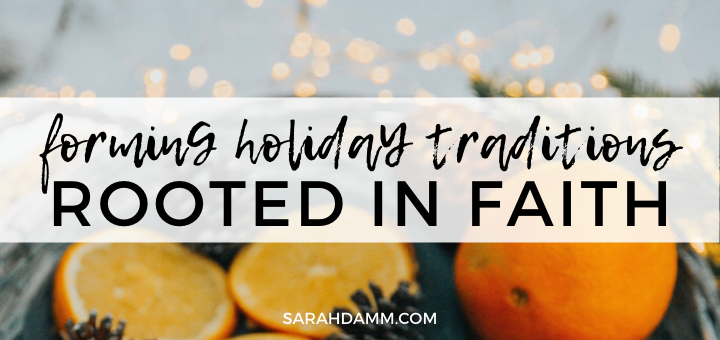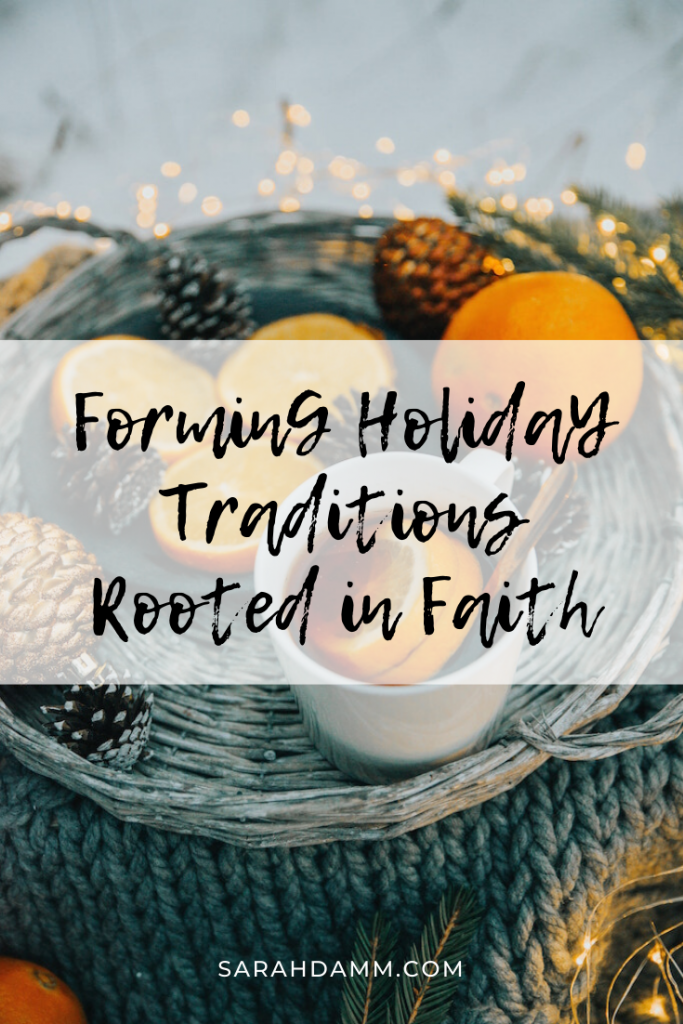
Forming Holiday Traditions Rooted in Faith
Walk into any store or tune into any radio station, and you would think Christmas is next week. The minute Halloween is over, Christmas is here. Never mind that it’s still very much fall, Thanksgiving is still a few weeks away, and Advent is the season that prepares us for the long-anticipated birth of Our Savior.
It can be hard to form holiday traditions rooted in faith, when we live in a very secular (and commercial) society. We hang stockings, decorate the tree, and give gifts. But perhaps we wonder why we do these things. Is there meaning behind these traditions? Or do we do them “just because”?
Holiday Traditions Rooted in Faith
Developing traditions takes time and patience. My family has tried things that simply didn’t click for us. Or some ideas worked well when we had two children but not as well with six. Eventually, the traditions that were meant to be ours took root in the hearts of each family member. And before we knew it, the kids started telling me, “That’s our tradition, Mom!”
And because we believe that Christmas is—and always will be—about God coming to dwell among us, we recognize how our holiday traditions are rooted in faith … while fun and nostalgic, too.
Counting the Days
Celebrating the season of Advent helps us prepare our hearts and homes to welcome Jesus on Christmas Day.
The Advent Wreath
The Advent wreath is a lovely connection between home and church, with Advent wreaths prominently set up in both places. My family enjoys the flickering light of the candles as the winter days grow darker. Our Advent wreath acts as a “Christmas countdown” of sorts, too, as we light another candle each week and the anticipation of Christmas grows.
Jesse Tree
Another way to countdown the days until Christmas is with the Jesse Tree. This custom traces Jesus’ lineage all the way back to Creation. Each day, we hang an ornament that corresponds with a Scripture reading. As each Bible story is read, we see a golden thread tying them together. And that thread is God. The Jesse Tree reminds us of God’s immense love and faithfulness. We see how He transforms the messiest situations by giving us a Savior. We recognize that the story of salvation is our story, too.
Decorating Glorifies God
It is quite customary to do a lot of decorating at Christmastime. In fact, we can have multiple bins of Christmas decorations that are enjoyed for only a few weeks each year!
And that’s OK.
Because we are celebrating Jesus’ birth, after all! And when we decorate to honor the Lord, of course we want every space to sparkle!
Often, the Christmas tree is the focal point of our Christmas-y homes. But perhaps we can turn greater attention to the nativity scene. One way to do this is by displaying it in a more central location. Add candles or twinkle lights. Make the scene a tiny altar, where we come to pray.
Decorating the tree helps us think about how God’s love is everlasting, just like the life of an evergreen. While stringing lights around the tree, we contemplate how Jesus is the light of the world, and His light “shines in the darkness, and the darkness has not overcome it” (John 1:5). And placing a star or angel on top, we remember the first Christmas when angels appeared to shepherds in the night sky and announced the birth of Jesus (Luke 2:8-20).
Think of Mary and how she must have kept her house for the Holy Family. I imagine it being tidy, peaceful, and ready to welcome family and friends. As we prepare our homes for Christmas next month, let’s ask for Mary’s intercession to focus on hospitality, not perfection.
Whether or not Santa Claus is part of your Christmas celebration, it is very popular to hang stockings somewhere in the home. This tradition can be linked to St. Nicholas, whose feast day is December 6th.
On St. Nicholas Day, fill shoes or stockings with chocolate coins and a small faith-based gift. Read The Night Before Christmas by Clement Clarke Moore. In this poem, “the stockings were hung by the chimney with care in hopes that St. Nicholas soon will appear.” This references the legend of St. Nicholas, who tossed bags of money through windows to help poor families. His generosity slowly evolved into the idea of Santa.
Giving Generously, Like the Wise Men
Can we even think about Christmas without thinking about gift giving? We may wonder why we do it, but we can’t imagine not doing it!
To make gift giving more meaningful, consider praying with the Scripture passage that tells the story of the Three Wise Men and the gifts of gold, frankincense, and myrrh that they gave to Jesus at His birth (Matthew 2:1-12).
As we contemplate giving Christmas gifts, let’s ask the Lord to fill our hearts with the generosity of the Wise Men.
Like the Wise Men, we can be lavish in our giving, even if we can’t spend a lot of money. For example, we can spend extra time visiting an elderly family member. We can help an elderly neighbor string lights on their house, or we can bake cookies for our parish priest.
Consider giving gifts that symbolize the gifts of gold, frankincense, and myrrh. Since gold is known to be valuable, the gold gift is something at the top of the recipient’s wish list. The frankincense gift is something that draws us closer to the Lord, just as our prayers rise up like incense (Psalm 141:2). And since myrrh is an ointment for the body, the myrrh gift is something practical, such as clothes, pajamas, or a new purse. This practice adds meaning to the presents we give (and receive) on Christmas Day, and it also simplifies the shopping.
Rooting Traditions in Faith is Easier Than You Might Think
Holiday traditions that we enjoy year after year are special for one reason or another. And the more we think about it, the more we discover how they are rooted in faith and help us celebrate the birth of Jesus.
What are some of your holiday traditions rooted in faith?

This article was first published at Blessed Is She.